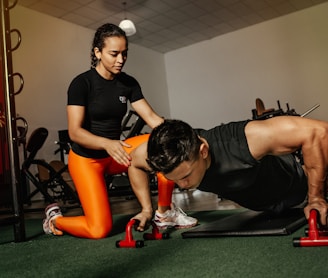Unlock Your Potential with Advanced Training Techniques for Athletes
Enhance your fitness level with these advanced training techniques for athletes, designed to take your performance to new heights.
FITNESS
7/21/20233 min read


Unlock Your Potential with Advanced Training Techniques for Athletes
Are you ready to take your fitness journey to a whole new level? In this article, we will explore some advanced training techniques that will help you achieve peak performance. Whether you're a seasoned athlete or just starting on your fitness adventure, these methods will push your boundaries and help you reach your goals like never before. Let's dive in and unlock your true potential!
1. High-Intensity Interval Training (HIIT)
HIIT is a game-changer for athletes. This technique involves short bursts of intense exercise followed by brief recovery periods. It not only torches calories but also improves endurance, boosts metabolism, and enhances cardiovascular health. Incorporate HIIT into your workouts to achieve maximum results in minimum time.
2. Periodization for Optimal Performance
Periodization is a strategic training approach that involves dividing your training program into specific periods or phases. Each phase focuses on different aspects, such as strength, endurance, or power. By varying the intensity and volume of your workouts, you prevent plateaus and keep progressing towards your fitness goals.
3. Plyometric Power Training
Looking to enhance your explosiveness and agility? Plyometric training is the answer. This technique involves powerful, rapid movements like jumps and throws. By incorporating plyometrics into your routine, you can boost your muscular power, reaction time, and athletic performance.
4. Functional Strength Training
Functional strength training focuses on movements that mimic real-life activities. It not only builds strength but also improves coordination and balance. This training is especially beneficial for athletes as it helps them perform better in their specific sports or activities.
5. Dynamic Stretching for Flexibility
Say goodbye to static stretching before workouts and hello to dynamic stretching. Dynamic stretching involves moving parts of your body through their full range of motion. This technique not only increases flexibility but also activates your muscles, preparing them for the workout ahead.
6. Cross-Training: A Holistic Approach
Cross-training involves engaging in different types of exercises or sports to balance out your training routine. By cross-training, you reduce the risk of overuse injuries and keep your body challenged in new ways, leading to overall improved performance.
7. Mind-Body Connection: Mental Training
Athletic performance is not just about the physical aspect; it also heavily relies on mental strength. Mental training techniques, such as visualization, goal setting, and mindfulness, can significantly impact your performance by boosting confidence and focus.
8. Nutrition: Fueling Your Performance
Your body is a machine, and the fuel you provide matters. Proper nutrition is vital for athletes to perform at their best. Focus on a well-balanced diet with the right proportion of carbohydrates, proteins, and fats, along with essential vitamins and minerals.
9. Recovery Techniques: The Road to Success
Rest and recovery are crucial components of any training program. Adequate sleep, stretching, foam rolling, and massage therapy aid in muscle recovery and reduce the risk of injuries. Remember, recovery is just as important as the training itself.
10. Tracking Progress: Data-Driven Training
Keep a record of your workouts, progress, and achievements. By tracking your data, you can identify patterns, strengths, and weaknesses, allowing you to make informed decisions to improve your training regimen.
11. Injury Prevention and Rehabilitation Strategies
Injuries are every athlete's worst nightmare. Incorporate injury prevention exercises and strategies into your routine to reduce the risk of injuries. In case an injury occurs, follow a proper rehabilitation plan to get back on track safely and efficiently.
Conclusion
Congratulations! You've now learned about various advanced training techniques that can take your fitness and athletic performance to a whole new level. Remember, consistency, dedication, and the willingness to push your limits are essential for achieving success in your fitness journey. Embrace these techniques, and you'll be amazed at the progress you can make.
FAQs
1. What is the best time to perform High-Intensity Interval Training (HIIT)?
Performing HIIT in the morning can give your metabolism a boost throughout the day, but the best time is when you can give it your all and stay consistent.
2. How often should I change my training program during periodization?
The ideal frequency is every 4 to 6 weeks. This allows your body to adapt to the current phase while keeping your workouts fresh and challenging.
3. Can anyone do plyometric training, or is it only for athletes?
While plyometric training is beneficial for athletes, it can be adapted for individuals of various fitness levels. However, beginners should start with proper guidance.
4. What is the importance of a rest day in cross-training?
Rest days allow your muscles to recover and repair, reducing the risk of overuse injuries and preventing burnout.
5. How can I overcome mental blocks during competitions?
Mental training techniques like visualization and positive affirmations can help you build mental resilience and overcome challenges during competitions.
Remember, your fitness journey is unique to you. Embrace these advanced training techniques, experiment, and find what works best for you. Stay consistent, be patient, and celebrate your progress along the way. Your dedication will unlock your true potential and lead you to peak athletic performance. So, what are you waiting for? Let's elevate your fitness game and embark on this exciting journey together
